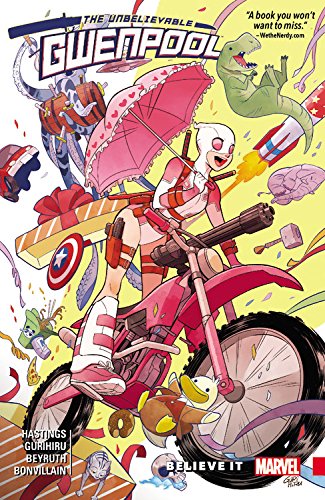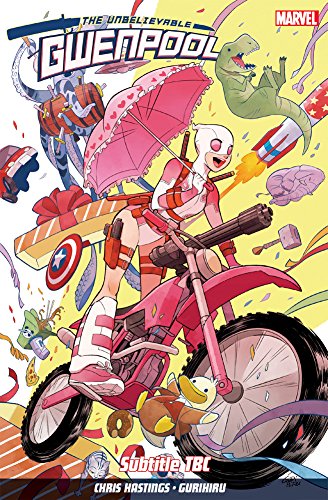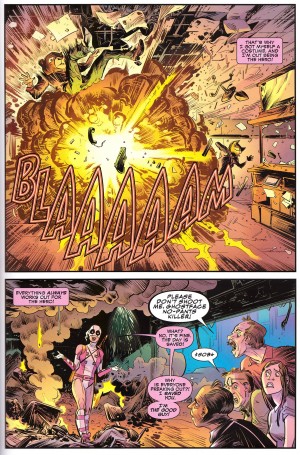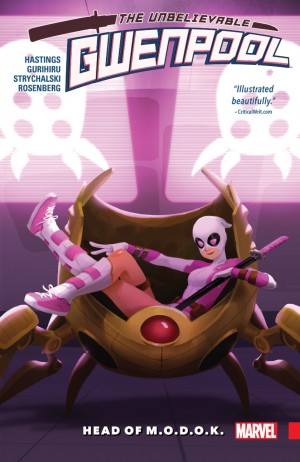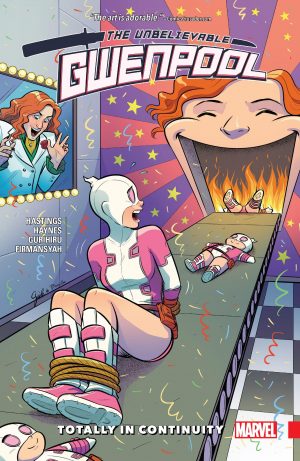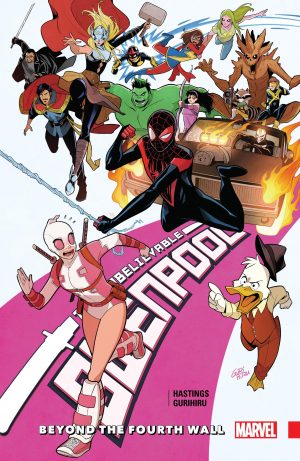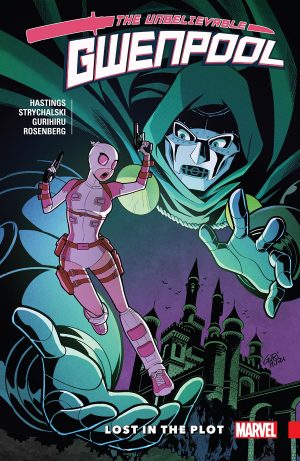Review by Frank Plowright
Despite the deliberately evocative name, at least for Marvel readers, Gwenpool is no relation to Gwen Stacy, Spider-Gwen or Deadpool, although her off the wall behaviour certainly owes more than a little to the latter’s wacky motormouth personality. In this opening graphic novel, however, much is kept mysterious. She notes she’s not from Marvel’s Earth, and where she’s from the folk in costumes are all comic and movie characters. She’s familiar with these, and an underplayed novel aspect is her awareness of their civilian identities.
Christopher Hastings has an eccentric approach to Gwenpool’s superhero activities. She has no super powers or combat training, and to all intents and purposes is a sassy teenage cosplayer, but she’s sustained by a belief she’s not in a real world, and in the Marvel universe the superheroes always win. Ergo, as long as she stays on the right side of the law she can’t come to any harm. However flawed this logic might be in philosophical terms, it works in situ, at least until she bumps into Modok.
Both She-Hulk and Deadpool have had periods where there’s a knowing breach of the fourth wall to address readers, and an awareness that they’re characters in a fictional environment, and it’s worked for both. It works equally well for Gwen, whose narrative captions are almost in the form of social media updates.
The art is wonderful. Brazilian Danilo Beyruth has a Mad Magazine facility for caricature, a loose cartoon line and a very effective busy all-movement style. Definitely an artist to watch out for. The anonymous Gurihiru Studios draw the remainder, actually a combination of artists Chifuyu Sasaki and Naoko Kawanu, and while theirs is a stock slick animation style, it lacks the individuality of Beyruth’s work. Kudos for a nice redesign on Modok, mind.
Another matter should be addressed: the reason for Gwenpool’s existence in the first place. As noted, there’s a resemblance to Deadpool, but her purpose in the Marvel universe is as an analogue to Harley Quinn, a fellow wacky motormouth for whom there was previously no Marvel counterpart. This lack of inspiration apart, Gwenpool develops into her own character.
Hastings is still finding his way over the shorter opening chapters, but once the issues from the regular series kick in he’s firing on all cylinders. Gwen’s likeable, and Hastings comes up with a wheelbarrow full of decent asides, such as superheroes handing out Christmas gift coupons, villainous organisations ensuring their payment arrangements are by the book and Modok merchandise for sale. Through it all Gwen charms, jokes and plots her way through preposterous and light-hearted situations, with the occasional encounter involving real danger.
Not everyone’s happy at Marvel’s 20teens policy of turning so many of their superhero titles into sitcoms, but surely with a new character there can be no complaints. Gwenpool is a lot of fun, and we need more superheroes in pink costumes. Head of M.O.D.O.K. follows, and all five Gwenpool trades by Hastings are combined in the Gwenpool Omnibus.
